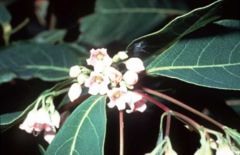Apocynum cannabinum
| Apocynum cannabinum subsp. var. | ||||||||||||||||||||||||||||||||||||||||||||||||||||||||
|---|---|---|---|---|---|---|---|---|---|---|---|---|---|---|---|---|---|---|---|---|---|---|---|---|---|---|---|---|---|---|---|---|---|---|---|---|---|---|---|---|---|---|---|---|---|---|---|---|---|---|---|---|---|---|---|---|

|
|
| ||||||||||||||||||||||||||||||||||||||||||||||||||||||
| ||||||||||||||||||||||||||||||||||||||||||||||||||||||||
Apocynum cannabinum (Dogbane, Amy Root, or Indian hemp) is a perennial herbaceous plant that grows throughout much of North America, in the southern half of Canada and throughout the United States. It grows up to 2 meters tall. It prefers moist places. It is a poisonous plant; the name means "poisonous to dogs". All parts of the plant are poisonous and can cause cardiac arrest if ingested.
The stems are reddish and contain a milky latex capable of causing skin blisters. The leaves are opposite, simple broad lanceolate, 7-15 cm long and 3-5 cm broad, entire, and smooth on top with white hairs on the underside. The flowers are produced in mid summer, with large sepals, and a five-lobed white corolla.
It grows in open wooded areas, ditches, and hillsides; in gardens it can be invasive, growing from spreading roots.
| Standard Cyclopedia of Horticulture |
|---|
|
Apocynum cannabinum, Linn. Branches erect or nearly so: lobes of corolla nearly erect, the tube not longer than calyx: Lvs. ovate to lance-oblong, short-petioled: cymes dense; fls. greenish white. Northern states; common.— Not known to be in the trade, but likely to be confounded with the above. Root emetic, cathartic, diaphoretic, expectorant, and diuretic. The tough fibrous bark of the stalks formerly used by the Indians for making twine.
|
Cultivation
Propagation
Pests and diseases
Varieties
Gallery
-
photo 1
-
photo 2
-
photo 3
References
- Standard Cyclopedia of Horticulture, by L. H. Bailey, MacMillan Co., 1963
External links
- w:Apocynum cannabinum. Some of the material on this page may be from Wikipedia, under the Creative Commons license.
- Apocynum cannabinum QR Code (Size 50, 100, 200, 500)
